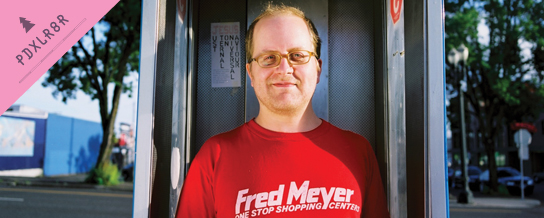Artist Tips: David Chandler
When XLR8R visited Portland’s David Chandler (a.k.a. Solenoid, DJ Brokenwindow, Mr. Pharmacist) back in 2004 […]

Artist Tips: David Chandler
When XLR8R visited Portland’s David Chandler (a.k.a. Solenoid, DJ Brokenwindow, Mr. Pharmacist) back in 2004 […]

When XLR8R visited Portland’s David Chandler (a.k.a. Solenoid, DJ Brokenwindow, Mr. Pharmacist) back in 2004 while we were putting together our Bedroom Rockers book, we could hardly find a place to stand amongst his overwhelming amount of synths, instruments, records, and tchochkes; the IDM/techno/electro specialist is a gear-loving packrat of the highest order. But when he’s about to set out on tour, his first priority is traveling light. And fortunately, those weight restrictions open up a world of creativity when it comes to performance. So save yourself those extra baggage fees, and check out Chandler’s tips for keeping your stage setup slim.
1. Use the club’s hardware
If you know that the club you’re performing at has a cool DJ mixer or some outboard effects box lying around, get the model number and look it up online to see what it can do (RTFM!). If it has a lot of good EQs or kill switches, plan your set around taking advantage of them. See if you can do a set with no external effects at all, and just work the DJ mixer instead.
2. Slim down
Try using only a drum machine and one synth. You’ll find you have to focus on deeper aspects of your hardware (knowledge you’ll be able to take advantage of forever after). See if some “bad” sounds in your crappy drum machine might be useful if pitched up or down or treated drastically. Maybe a low tom can be tweaked into a great bass drum or sequenced as a bass. Most people never use 90% of their technology’s programming potential, so explore one synth really deeply and leave the second one at home.
3. Use your drum machine’s memory
If you have a song with only a few patterns, duplicate copies of your good patterns into other slots and shift a few notes, pitches, or volumes. Try changing the syncopation at the end of the bar. To have these variations available when you are improvising can give a lot of room to play longer. Besides, bringing your drum machine to a gig with empty patterns is silly. A full memory takes up the same amount of space in your bag as a half-empty one.
4. Use the extra outputs in your hardware
Instead of running your drum machine out to just stereo channels, try assigning the bass drum or hi-hats to one of the extra outputs. Obviously, this would let you create isolated effects (classic Detroit techno often abused this idea in a charming way), but the most practical result is that you can isolate control of the volume and EQing. This lets you create subtle variety while still staying with a single looping drum pattern.
5. Keep your sounds varied
Use those LFOs and chorus speeds to give your synth sounds or samples an almost imperceptible sense of variety. Don’t leave an LFO untouched. Using a little LFO against the pitch of a melodic sample creates a subconscious sense of instability, which a person’s brain will fixate on. LFOs changing the pitch of rhythm samples may ruin a beat’s perfect timing, but that can be a good thing. “Perfect” quickly becomes monotonous, and a tiny modulation can prevent your audience from tuning you out. Unchecked monotony is how drum machines and sequencers got a bad name.

